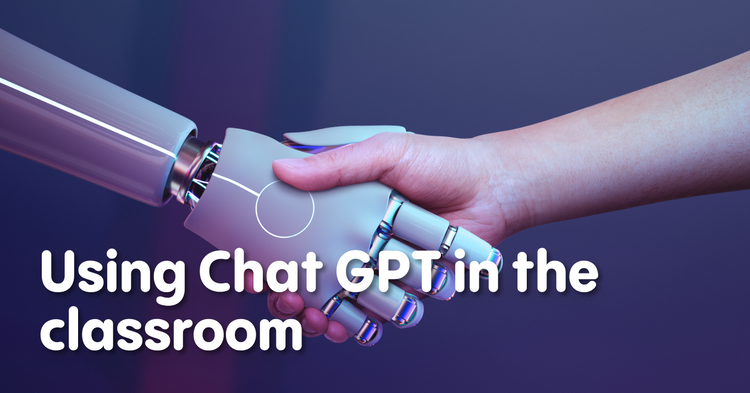It was only a matter of time before academics began investigating artificial intelligence's (AI) possibilities in the classroom, given how quickly AI is developing in a variety of industries.
ChatGPT, an AI language model that can produce text that resembles human speech, is one AI application that has attracted the interest of educators all around the world.
Teachers can save time and foster an interesting learning environment for their students by utilizing ChatGPT's many advantages. Allright.com shares a guide on how teachers might use ChatGPT in their classes, and what the future of AI and education holds.
What is ChatGPT, and how can teachers use it in the classroom?
Introducing the features of ChatGPT
An artificial intelligence technology called ChatGPT can produce text that sounds like human speech when given a topic or cue. It belongs to the family of neural network models called GPT (Generative Pre-trained Transformer) that have been trained to produce text that resembles human writing. The model can produce contextually appropriate responses to user queries since it is built upon a sizable corpus of text that has been fed into it during the training phase.
How to include ChatGPT in a lesson plan for teachers?
Asking ChatGPT to generate writing prompts for their students is one way teachers can use it in the classroom. This might be especially useful for teachers who are having trouble coming up with ideas for homework or class tasks. Students can find a range of ideas for essays, reports, and other writing assignments on ChatGPT.
ChatGPT can also save teachers' time by grading their assignments. The ability to train ChatGPT on a rubric enables it to grade student work according to predetermined standards. As a result, teachers may be able to grade assignments more quickly and give comments to students more quickly.
How Teachers could save time and effort by using ChatGPT?
By giving students an AI-generated framework to direct their writing, ChatGPT can also be used to help students write outlines. Teachers who don't have the time to make thorough outlines for each student or struggling writers who may not know how to organize their thoughts properly may find this to be of particular use. Try this tool to make your teachers' life easier.
What are some instances of the employment of AI by educators in the classroom?
Using ChatGPT, a chatbot, to encourage student writing
It has been claimed that many teachers ask their kids to write by employing chatbots like ChatGPT. They can give ChatGPT a topic or prompt, and it will come up with a number of options for them to choose from. This can be beneficial for students who are experiencing writer's block or may not know where to begin with a writing assignment.
AI-assisted assignment evaluation
Assignment grading is another method AI is applied in the classroom. Teachers can speed up the grading process and give students feedback more quickly by using an AI bot like ChatGPT to grade assignments in accordance with a predetermined rubric.
AI to prevent students from plagiarizing on assignments
The capability to prevent cheating students from utilizing artificial intelligence to produce their papers is one aspect that many educators find useful. It is possible to train ChatGPT to spot previously published passages and mark them as copied or plagiarized. This can assist teachers in making sure that students are completing assignments independently and understanding the material being covered in class. Use this tool to prevent cheating.
How should educators incorporate ChatGPT or other AI tools into their lessons?
Developing lesson ideas with AI in mind
The creation of lesson plans with AI capabilities in mind is one of the essential elements of successful AI integration in the classroom. Teachers should think about how ChatGPT and other AI tools may help student learning and improve instruction.
Use efficient rubrics when grading projects graded with AI
Teachers must make sure that the rubric they employ is functional and will fairly evaluate student work before using an AI bot like ChatGPT to grade assignments. This can entail educating the AI tool on particular rubrics or developing a brand-new rubric just for the AI tool.
AI-generated outlines are used to organize the writing prompts for students
Teachers should think about how they can use AI technologies like ChatGPT to improve their instruction as they become more common in the classroom. This can be accomplished, for example, by structuring student writing assignments using AI-generated outlines. This can give pupils a clear outline to adhere to while also assisting in the development of their writing skills.
Conversation Practice
ChatGPT can serve as a conversational partner for students. Students can practice their speaking and listening skills by having a conversation with ChatGPT on a given topic.
Vocabulary Building
Teachers can use ChatGPT to introduce new vocabulary to students. They can ask ChatGPT to provide synonyms or antonyms for words, or use ChatGPT to generate sentences that include new vocabulary words.
Writing Exercises
Students can use ChatGPT to practice writing skills by asking ChatGPT to provide writing prompts or to give feedback on their writing.
Pronunciation Practice
ChatGPT can help students practice their pronunciation by repeating words or phrases after ChatGPT.
Cultural Knowledge
ChatGPT can also be used to provide students with cultural knowledge. Teachers can ask ChatGPT to provide information about a particular culture or country.
What are some possible negative effects or issues with implementing AI in the classroom?
Ensuring the ethical application of AI
The requirement to ensure ethical use of the technology is one potential disadvantage of utilizing AI in the classroom. Teachers must ensure that AI apps are utilized responsibly and that kids are not being unfairly or discriminatorily treated.
Addressing the problem of bias in AI-generated material Bias in AI-generated content is another potential issue when utilizing AI in the classroom. Teachers must be aware of the biases that can be present in AI models and ensure that their teaching methods do not support or reinforce these biases.
The significance of juggling the integration of AI with conventional educational techniques
Although AI can be a useful tool in the classroom, it's crucial to keep in mind that it shouldn't completely replace conventional teaching techniques. To guarantee that students obtain a well-rounded education that equips them for real-world difficulties, teachers must strike a balance between the usage of AI and more conventional teaching techniques.
What does the future of education and AI hold?
The possibility for implementing AI in K–12 education
There are a lot of intriguing ideas for how AI can be applied in education in the future. AI in K–12 education can assist teachers in giving students more individualized learning experiences and giving them real–time feedback on their development.
The appearance of additional AI-assisted teaching resources
There will surely be new AI technologies that appear to support instructors in their teaching techniques as AI develops and becomes more sophisticated. These resources could include sophisticated AI systems that can offer comprehensive statistics and metrics on student performance, as well as chatbots like ChatGPT.
How instructors may keep up of AI developments and apply them in the classroom
It's critical for teachers to remain on top of AI developments and understand how they may be brought into the classroom. Attending conferences or workshops, investigating cutting-edge AI tools and technologies, or working with other educators to exchange best practices and cutting-edge teaching techniques are all possible ways to accomplish this.
In conclusion, AI can be a potent tool for educators who want to give their pupils a more engaging learning environment. We can anticipate more teachers implementing AI technologies like ChatGPT in their classrooms to give students individualized learning experiences and real-time feedback on their progress as AI continues to advance and become more sophisticated.








